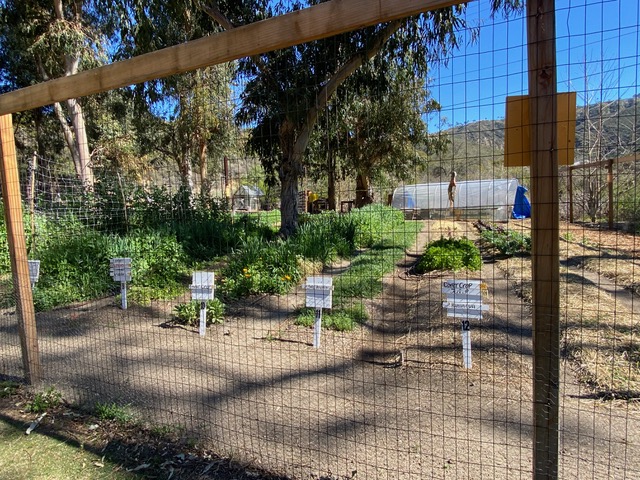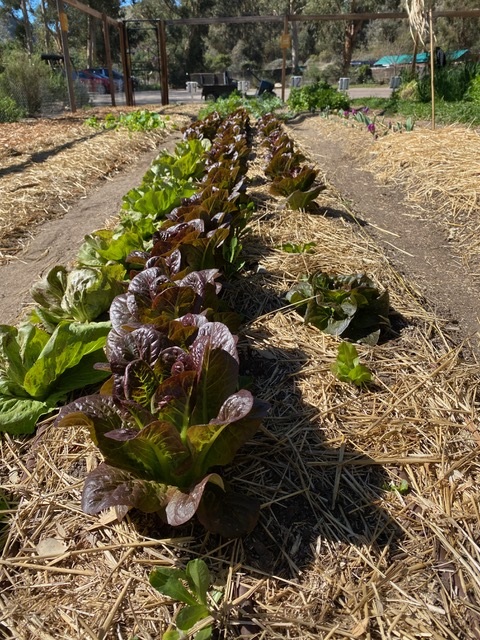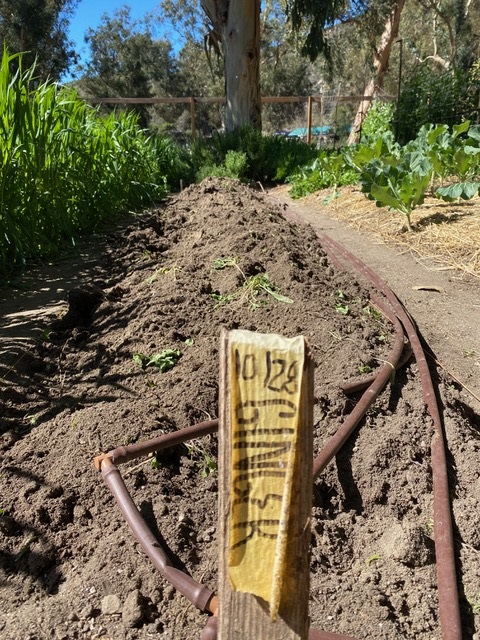| |
Leo's Organic farm is located in a canyon near Laguna Beach. It's about 1/3 acre. It provides food for the Harvest Restaurant at the Ranch at Laguna Beach, a 5 star restaurant on a seasonal creek nestled in a high walled canyon that empties into the Pacific Ocean. The Hotel features a golf course. See https://www.theranchlb.com/dine/harvest .
We surreptitiously walked up the golf course to visit the farm. We did so because we had two delicious dinners which featured home grown salads that were radiant, tasty and fresh.
The Harvest Restaurant's connection to the farm is exactly the model we're seeking to emulate at Worthy. I spoke to both Leo and his helper, Maile, 808.369.4736, and they are energetic, dedicated, humble, smart, and inspirational. They are available to bounce ideas off of. Note that their farm is situated on a sandy canyon bottom in an arid place shaded by Eucalyptus trees. They use very little water. They basically create their own soil. The brain center of the farm is their compost system. They take raw vegetable scraps, add shredded office paper, and combine with straw. They add very little water and turn once every ten days or so. They sprinkled the compost on the beds after each harvest.
The below are photos. Please examine. The signage is educational, thoughtful, and fun. It's very well done. It's part of a self-guided tour. They don't draw many visitors because its located at the opposite end of a hoity toity golf course. Worthy of course will prominently feature our garden.
This is exciting stuff. There are many opportunities to take their example and turn it into a living food and soil laboratory. Please scroll through the below.
Fresh Food for Life!
Roger, Feb. 24, 2021 |
***************************************************************************************
| |
 |
| |
|
|
| |
 |
| |
|
|
| |
*************************************************************************************** |
| |
|
|
| |
Worthy Brewing's Organic Farm.
Add communal farming to the brewery's list of cool side projects
BY BRIAN YAEGER
Bend Source. May 19, 2021
Click here |
 |
| |
|
|
***************************************************************************************
| |

|
|
| |

14 rows, 50 feet long, about 3 feed wide, with a walking lane in between. Multiple drip lines. In the off season they grow cover crops, which eventually they dig under after harvesting biomass for composting. Each row is given a number. They have a placard system that identifies each crop or flower
|
|
| |

|
|
| |
|
|
| |

Half tunnel. This is interesting. They dont use preffabed nutrient cubes for cuttings. They create their own soil and then cross hatch, using the same tray, avoiding throwaway plastic treys. “Soil Blocks.” Very low cost, sustainable, and effective.
|
|
| |

The Harvest Restaurant utilizes several lettuces, kale and arugala.
|
|
| |

|
|
| |
|
|
| |

Arugala in late February!
|
|
| |

|
|
| |
|
|
| |

|
|
| |
|
|
| |

They use straw from hay bales for mulch as ground cover (see sign for explanation). The webbing is for climbing legumes. They connect the netting to the posts using clamps.
|
|
| |

|
|
| |
|
|
| |

Compost World! They make it look very simple. The compost world is fed daily by the restaurant non meat scraps. They turn over the compost every 10 days to 2 weeks. They dont get much rain. When they do, they cover the mound with a tarp. They dont use much hose water. There was no smell. They even use shredded office paper. This presents an excellent opportunity to educate visitors about the genesis of soil, including the decomposition of organic materials. Again, the native soil is sandy river bottom. It's not much different than our basalt based ground at Worthy.
|
|
| |

They sift the composted soil over a screen into a wheelbarrow. We will need to locate a good spot for the composting as it is the foundation of what we are trying to teach, model and utilize.
|
|
| |

No smell, no flies, no pooling, no untidiness. Where can we locate our compost? It has to be readily accessible from our kitchen. Of course we'll need to work out the schedule for sourcing and turning and eventually amending.
|
|
| |

Pile of straw. Notice the dryness. Much of the yard is shaded with Eucalyptus trees, whose leaves are acidic.
|
|
| |

Here's the chicken coop. They name their chickens. In a few weeks they will add 15 chickens. The chickens create eggs. They do not enter the garden and are kept behind the high fence. No mention of whether they utilize the chicken manure for fertilizer. Read their signage. Frankie, alas, died a few days ago.
|
|
| |

|
|
| |
|
|
| |

|
|
| |
|
|
| |

|
|
| |
|
|
| |

Very rustic, organic, non flashy signage. Public access very tough. No walking path. Farm separated from hotel by about 1 km of golf course, which frowns on strollers. A true gem I knew nothing about, and Ive lived in nearby Dana Point for 25 years and drove and cycled by this canyon entry a few million times.
|
|
| |

|
|
| |
|
|
| |

They number each row, identify each crop, and note the date of planting.
|
|
| |

|
|
| |
|
|
| |

|
|
| |
|
|
| |

Snap Peas, I think. Flourishing.
|
|
| |

|
|
| |
|
|
| |

At the bottom of the 8 ft fence they reinforce with chicken fencing to prevent small rodents from entering. Gophers are the biggest intruders.
|
|
| |

They string the length of each bed on both sides. Adds order and structure.
|
|
| |

Harvesting cover crop biomass for composting before a fresh planting. Again, not the stringing and clean space between each bed.
|
|
| |

A happy garden brimming with love and health! A simple and compelling link to the delicious food served at the hotel's restaurant. To my knowledge the only fresh garden fed restaruant in Orange county.
|
|
| |

Native soil and ecosystem on the other side of the high garden deer fence. Note the dryness, sandiness, and sparse ground cover. The garden soil is raised a few inches from the surrounding native hardscape.
|
|
| |

|
|
| |
|
|
| |

|
|
| |
|
|
|